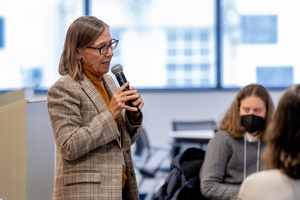Faculty Expert
When April arrives, it is usually crunch time for graduating high school seniors to evaluate their financial aid packages and select their college. However, some members of the Class of 2024 are in limbo. After a rocky rollout of the federal government’s new Free Application for Federal Student Aid (FAFSA), some families still await financial aid packages, which is critical in picking a college.
The FAFSA determines a student’s eligibility for federal financial aid, including loans, grants, and work-study. In a typical year, the form is available to students in October, families receive financial aid offers from schools by March, and students commit to a school by May 1.
This year, the new FAFSA wasn’t ready until late December, and outages and technical glitches immediately hobbled the system. That created a ripple effect, upending the usual timeline.
Despite the tumult, GSE Centennial Presidential Professor of Education and Penn’s Vice Provost for Faculty Laura Perna, who specializes in college access, affordability, and success, says students should complete the FAFSA as soon as possible. They should also recognize that colleges and universities are working hard to get them their financial aid offers as soon as possible.
“It is so important for students, especially low-income students and first-generation students, to complete the FAFSA as they try to identify ways to pay for college,” Perna said. “It is foundational to being eligible for federal aid as well as some state and institutional.”
To support students and families, Perna shares her thoughts on navigating the disruptions and how the new application will help future applicants.
The new FAFSA reduces barriers
The former FAFSA was notoriously tedious, requiring some students to answer as many as 108 complex questions. Perna says the new application is more manageable and more accessible to complete.
The revamped form asks as few as 36 questions and pulls some financial information from the Internal Revenue Service. That reduces the information students and parents need to gather and submit, saving time and headaches.
The revamped FAFSA also includes an updated formula to calculate student aid, which should expand eligibility.
More students should qualify for Pell Grants
The Pell Grant program provides need-based grants to low-income undergraduates. Because these are grants, they don’t need to be repaid. However, every year, students leave billions of federal grant money on the table because they don’t submit FAFSAs.
Perna says the simplified FAFSA should allow more students to complete the form and access these coveted grants. For its part, the Department of Education says the redesigned FAFSA will help 1.5 million more students access Pell Grants for the 2024–25 award year, bringing the total number of awards to more than 5.2 million.
Inquire about deadlines for acceptance
Due to the FAFSA delays, some college applicants are weighing acceptances without a complete picture of their aid packages.
To ease pressure, more than 235 colleges and universities have pushed that date back to May 15, June 1, and even July 1, according to a directory compiled by the National Association of College Admissions Counseling. Other schools encourage students to contact financial aid offices and admissions officers to discuss options.
Perna encourages students to take advantage of these extensions.“Students and families need time to understand their financial aid offers in order to decide where to go to college and how they’ll pay the costs,” she said.
Lean on school counselors and advocates for support
Even with extensions, school acceptance deadlines loom. Graduating seniors and their families can turn to their high school counselors and community organizations for support and assistance. Perna says families can seek help navigating the new forms and technical support. Students should stay in touch with the financial aid and admissions offices at the colleges where they have been admitted. They should ask for updates on their offer status and be sure they know the deadlines and deposit requirements.
Finish the FAFSA as soon as possible
Most importantly, Perna says students who haven’t already done so must submit their FAFSA immediately.
Students need a completed FASFA to unlock federal aid, and some state and institutional awards are available on a first-come, first-served basis or have early deadlines. That adds urgency to finishing the FAFSA, Perna said.
“Figuring out how a student is going to pay the cost of going to a particular college is critically important,” Perna said. “It is essential to complete the form.”
Media Inquiries
Penn GSE Communications is here to help reporters connect with the education experts they need.



